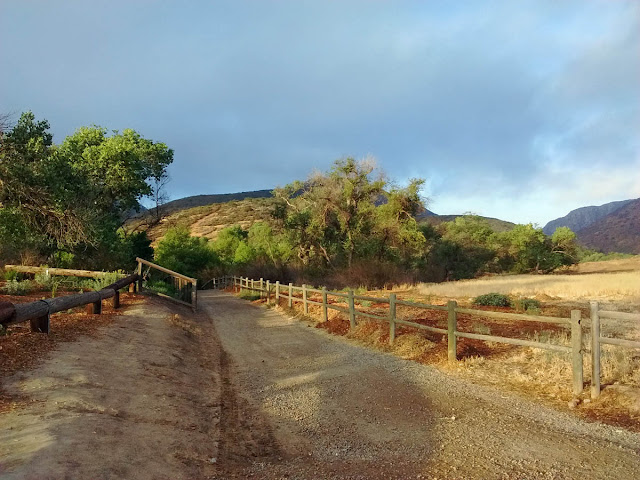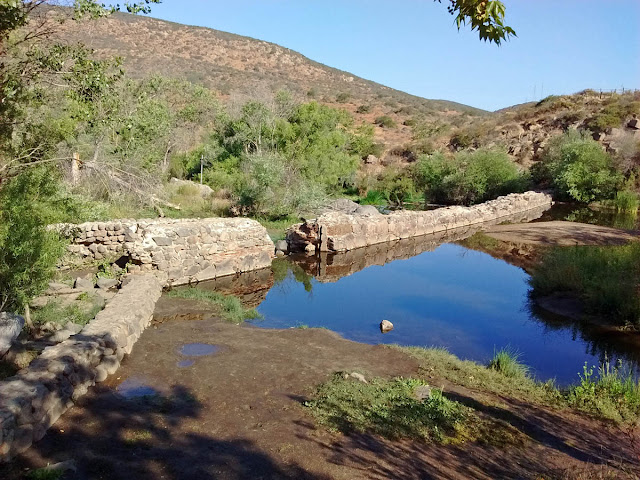On the eastern edge of the City of San Diego lies the 5800 acre Mission Trails Regional Park--the largest city park in California.
In size, it is similar to the 5100 acre Forest Park in Portland, Oregon. As with its Oregon counterpart, Mission Trails (official
website) is equally beloved by hikers, mountain bikers, equestrian riders and, of course, bird watchers.
There are many areas within the park where you may find good bird watching. Perhaps the most popular is the Old Mission Dam area and Kumeyaay Lake. This area is especially productive in late April and May for spring migrants.
Getting there: 19 miles from San Diego airport taking Hwy 163, then Hwy 52 to Santee, exiting at Mast Blvd (Exit 13), left on Mast Blvd, right onto West Hills Parkway, right on Mission Gorge Rd, and right on to Father Junipero Serra Trail.
ONE WAY WARNING: Father Junipero Serra Trail is one way 3 miles from Mission Trails Visitor Center on the south end of the park to Old Mission Dam. But Mission Gorge Rd is actually faster to go around.
Parking: FREE, just off Mission Gorge Rd at the intersection with Bushy Hill Drive and across the street from Cumeyaay Lake Campground.
Hours: The main road through the park, Father Junipero Serro Trail, is CLOSED except 9:00 a.m. to 5:00 p.m. Park as indicated above and walk in starting at dawn.
Map navigation: Parking lot is approximately 10599 Father Junipero Serra Trail, Santee, California 92071 [The campground across the street is addressed as 2 Father Junipero Serra Trail, San Diego, California 92119.]
Where to bird: Park in the FREE dirt parking area across from Kumayaay Lake Campground (map location A). Walk through the campground to the trails that lead around both sides of Kumeyaay Lake (map location B). Unfortunately, the trails do not circle the lake completely. The trail on the south side of the lake goes east to the road you can see at the edge of the map below. Besides several species of ducks and water birds, Least Bittern is found here, though a skulker. Bell's Vireos can be found in summer. Taking trails on both sides of the lake and back to the parking area is probably about 3/4 of a mile.
After finishing the lake and campground, walk the road (Father Junipero Serra Trail) to a well-marked gate that leads down into the riparian zone and out to a grassland (map location C). This river crossing thicket has Yellow-breasted Chats and is good for flycatchers and warblers in spring and early summer.
 |
| North of map location C looking south to San Diego River. |
Continue northward on the trail out into the grassland and follow the trail toward Spring Canyon (map location D). On the way you may expect Greater Roadrunner. As you reach the wet area with scattered small trees you'll hear more Yellow-breasted Chats and find Blue Grosbeaks and Lazuli Buntings.
 |
| North of map location C looking north toward map location D. |
From here I backtrack just a bit and take one of the two trails across the rolling grassland westward (map location E). My target species here is Grasshopper Sparrow. These are best detected singing at dawn on calm mornings. If there is any breeze (or flyover planes) you won't be able to detect the soft insect-like buzzy song.
Once you reach the Oak Canyon Trail on the western edge of the map above you encounter many chaparral birds such as California Thrasher and Phainopepla.
Soon you enter the lush area of the San Diego River at the Old Mission Dam (map location F). Again, this is a great place for Pacific-slope Flycatchers, Bell's Vireos, Downy Woodpeckers (rather local in San Diego County), and other neotropical migrants. There is a small crowded parking lot here but, as mentioned, it does not open until 9:00 a.m. You really want to be leaving soon thereafter anyway, as the best birding is within 3 hours of dawn, and it can become quite warm by mid-morning.
 |
| Old Mission Dam |
The loop from C to D to E to F and back to the parking lot at A is about 2 miles. So, adding the nearly mile of the Kumeyaay Lake trail, the total walking distance is 2.5 to 3 miles. If you want to go farther there are 50 miles of trails and several peak trails to challenge the more physically fit.
On the other hand, I can understand if the campground was full so you decide to skip the lake, you didn't want to walk out the grassland, and you just birded from the parking area (A) to the San Diego River (C) and around Old Mission Dam (F) looking for spring migrants. That would limit the walking to just about a mile or so without sacrificing too many species--and may actually lead to more species by spending more time in the most productive habitat.
Here is an
eBird bar chart showing the weekly status of 183 species in 3 hotspots listed for eBird in this small portion of the park (Mission Trails Regional Park: 1) Kumeyaay Lake & campground, 2) Oak Canyon Trail, and 3) northeast region).
Here are a few of my personal eBird checklists from the area:
May 10, 2015
Old Mission Dam and Grasslands
October 4, 2013
Old Mission Dam and Grasslands
April 20, 2014
Kumeyaay Lake and campground






